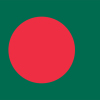INTELLECTUAL PROPERTY RIGHTS IN BANGLADESH

Opposition Term |
02 Months |
Registration Term |
07 Years |
First Renewal Term |
10 Years |
Subsequent Renewal Term |
10 Years |
The Trademarks Act, 2009 is the primary law governing the mechanism of trademark registration and protection in Bangladesh.
For getting a trademark registered in Bangladesh, an application has to be filed with the Department of Patents, Designs, and Trademarks (DPDT) under the Ministry of Industries (MOI), which administers the entire trademark registration process.
It follows a 'first to use' system, which subjects to presenting evidence of prior use of the mark in the country.
Bangladesh follows the 9th edition of Nice Classification. Multi-class trademark applications are not acceptable.
The third parties can file opposition actions against a trademark application within two (02) months following its publication date in the official gazette.
In Bangladesh, registered trademarks have a validity of seven (07) years from the date of application, which can be further renewed indefinitely for successive periods of ten (10) years each.
The grace period to renew a trademark after the date of expiry is six (06) months.
The term for cancellation of a registered trademark based on non-use is five (05) years from the date of registration.
Bangladesh is a member of the Paris Convention for the Protection of Industrial Property.
The Patents & Designs Act, 1911 and the Patent and Design Rules, 1933 (as amended up to 15th June 1946) deal with the mechanism of patent protection in Bangladesh.
For seeking patent protection in Bangladesh, an application has to be filed with the DPDT, which administers the entire process of patent grant.
In Bangladesh, an invention that satisfies the conditions of originality, novelty, inventive step, and industrial applicability, subjects to patentability. Process patent and product patent are the two types of patents that can be protected.
The types of patent applications that can be filed include Non-Convention Application and Convention Application.
In Bangladesh, an opposition against a patent application can be raised at the pre-grant stage within two (02) months approximately.
The patent of invention lasts for sixteen (16) years in Bangladesh. The first annuity will be due in the 4th year, and the last annuity will be due in the 15th year. The payment of annuities can be made any time before the due date.
The Patent & Design Rules, 1933 (as amended up to 15th June 1946) governs and deals with the mechanism of registration of industrial designs in Bangladesh.
For getting an industrial design registered in Bangladesh, an application has to be filed with the DPDT, which administers the entire process of registration.
The types of industrial design applications that can be filed in Bangladesh include Non-Convention Application and Convention Application.
Utility model protection isn't provided under industrial design protection in the nation.
Opposition against an industrial design application can't be raised in Bangladesh.
The total duration of industrial design registration in Bangladesh is fifteen (15) years from the date of application. The initial registration term is five (05) years, which is further extendible for two (02) terms of five (05) years each upon payment of the renewal fee.
The time frame for payment of the renewal fee before the due date is six (06) months.
There is no grace period to renew a registered industrial design.
Bangladesh is a signatory to the Berne Convention for the Protection of Literary and Artistic Works.
The Copyright Act, 2000 is the basic legislation governing copyright protection in Bangladesh.
In Bangladesh, copyright comes into existence as soon as a work is created. No formality is required to be done for getting a copyright. However, one can avail some facilities for having the work registered in the Register of Copyright at the Copyright Office under the Ministry of Culture Affairs. A certificate is issued by the Registrar of Copyright that makes prima-facie evidence of ownership of copyright.
The standard copyright protection term lasts for the lifetime of the author plus sixty (60) years following his death. However, the duration of copyright protection varies depending on the type of work.
Copyright in a literary, dramatic, musical, or artistic work published within the lifetime of the author subsists until sixty (60) years from the beginning of the calendar year next following the year in which the author dies.
Copyright in a cinematographic film, a sound recording, a photograph, a computer program or a work of the government, a local authority, or an international organization subsists until sixty (60) years from the beginning of the calendar year next following the publication of the work.

